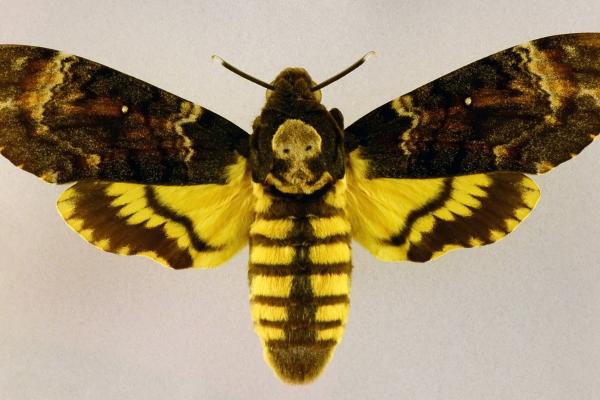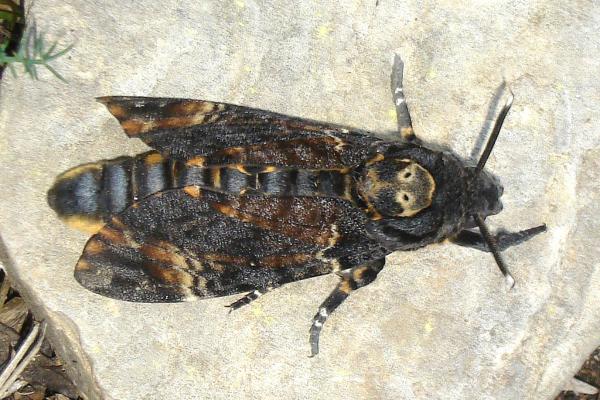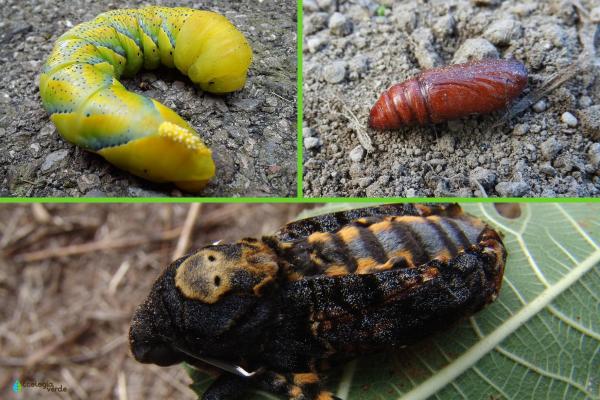The Death's-head Hawkmoth (Acherontia atropos) is a large nocturnal moth belonging to the genus Acherontia, known for its distinctive skull-like marking on the thorax. This eerie pattern has made it the subject of myths and legends across cultures and earned it a place in popular culture, such as its appearance in the movie The Silence of the Lambs.
In this article, we’ll explore the unique features, habitat, feeding habits, and life cycle of this mysterious insect often associated with omens of death.

The most notable trait of Acherontia atropos is the skull-shaped pattern on its thorax, but it also displays several other remarkable characteristics:
Coloration: The thorax is dark brown or black, with the skull marking appearing in a contrasting pale yellow or orange hue.
Wings: The forewings are larger and typically dark brown or ash black. The hindwings are smaller, cream to orange, and feature two darker parallel bands near the edge.
Size: When fully spread, wingspans typically range between 8 to 12 cm, though larger specimens have been recorded.
Sexual Dimorphism: Females are generally larger, with a rounded abdominal tip and thicker, longer antennae than males.
Sound Production: Uniquely among moths, the Death's-head Hawkmoth emits a high-pitched squeak, not by rubbing body parts but via a vibrating structure in its pharynx. The reason for this sound is still debated—it may deter predators or mimic the queen bee’s call, allowing the moth to enter hives undetected.

Due to its skull-like marking, the moth is often called the "Moth of Death."
It is associated with death, war, disease, and famine in folklore across Europe.
In parts of central France, people once believed that if a moth scale fell into someone’s eye, it could cause blindness.
The scientific name reflects this dark symbolism:
"Acherontia" refers to Acheron, the river of lost souls in Greek mythology.
"Atropos" is one of the three Fates in Greek mythology, responsible for cutting the thread of life, thus ending a mortal’s time.
The Death's-head Hawkmoth is widely distributed across:
Africa: Especially common in the northern regions, but absent from desert zones like the Sahara.
Middle East and Mediterranean Basin.
Europe: Found during the warmer months. With climate change, sightings are increasingly common further north, though they cannot survive harsh winters.
Feed primarily on nectar and sugary substances such as fruit juice and honey.
Notably, they can enter beehives and consume honey without being attacked by worker bees—possibly due to their queen bee-mimicking sound.
The caterpillars feed mainly on solanaceous plants, with potato leaves being their favorite.
Typically found in low numbers, they rarely cause significant agricultural damage but are considered minor pests in some regions.
The moth undergoes complete metamorphosis, including egg, larva, pupa, and adult stages.
Females lay single eggs at the base of host plants, primarily potatoes, tomatoes, and eggplants.
Can grow up to 13 cm in length and progresses through four stages:
Initial stage: Pale green with diagonal yellow stripes.
Second stage: Develops a thorny, dark-colored horn on its back.
Third stage: Lateral stripes intensify with blue or purple edges; horn turns yellow.
Final stage: Turns uniform brown, green, or yellow; horn disappears.
The caterpillar secretes a saliva-like substance and buries itself underground to pupate.
The pupa is protected by a hardened outer shell, within which it transforms into an adult moth.
Adult coloration does not differ significantly between males and females.

Despite its ominous reputation, the Death's-head Hawkmoth is a fascinating and uniquely adapted insect. Its striking appearance, cryptic behavior, and intriguing biology make it a wonder of the moth world and a reminder not to judge nature’s creatures by appearances alone.
Referencias
Kitching, I. (2016). The biology of Death’s Head Hawkmoths, lepidopteran kleptoparasites of honey bees. Disponible en: https://nhm.openrepository.com/bitstream/handle/10141/622692/Kitching%2c%20I.J.%202006.pdf?sequence=1&isAllowed=y
animal tags: Acherontia atropos
We created this article in conjunction with AI technology, then made sure it was fact-checked and edited by a Animals Top editor.